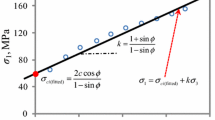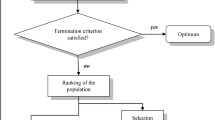Abstract
Complexity of analysis of geotechnical behavior is due to multivariable dependencies of soil and rock responses. In order to cope with this complex behavior, traditional forms of engineering design solutions are reasonably simplified. Incorporating simplifying assumptions into the development of the traditional methods may lead to very large errors. This paper presents an endeavor to exploit a robust multi-gene genetic programming (MGGP) method for the analysis of geotechnical and earthquake engineering systems. MGGP is a modified genetic programming approach for model structure selection combined with a classical technique for parameter estimation. To justify the abilities of MGGP, it is systematically employed to formulate the complex geotechnical engineering problems. Different classes of the problems analyzed include the assessment of (i) undrained lateral load capacity of piles, (ii) undrained side resistance alpha factor for drilled shafts, (iii) settlement around tunnels, and (iv) soil liquefaction. The validity of the derived models is tested for a part of test results beyond the training data domain. Numerical examples show the superb accuracy, efficiency, and great potential of MGGP. Contrary to artificial neural networks and many other soft computing tools, MGGP provides constitutive prediction equations. The MGG-based solutions are particularly valuable for pre-design practices.
















Similar content being viewed by others
References
Shahin MA, Maier HR, Jaksa MB (2001) Artificial neural network applications in geotechnical engineering. Austr Geomech 36(1):49–62
Cao M, Qiao P (2008) Neural network committee-based sensitivity analysis strategy for geotechnical engineering problems. Neural Comput Appl 17:509–519
Alavi AH, Gandomi AH, Gandomi M, Sadat Hosseini SS (2009) Prediction of maximum dry density and optimum moisture content of stabilized soil using RBF neural networks. IES J Part A Civil Struct Eng 2(2):98–106
Cabalar AF, Cevik A (2009) Modelling damping ratio and shear modulus of sand-mica mixtures using neural Networks. Eng Geol 104:31–40
Alavi AH, Gandomi AH, Mollahasani A, Heshmati AA, Rashed A (2010) Modeling of maximum dry density and optimum moisture content of stabilized soil using artificial neural networks. J Plant Nutr Soil Sci 173:368–379
Metenidis MF, Witczak M, Korbicz J (2004) A novel genetic programming approach to nonlinear system modelling: application to the DAMADICS benchmark problem. Eng Appl Art Int 17:363–370
Koza JR (1992) Genetic programming, on the programming of computers by means of natural selection. MIT Press, Cambridge
Alavi AH, Gandomi AH (2011) A robust data mining approach for formulation of geotechnical engineering systems. Eng Comput 28(3):242–274
Gandomi AH, Alavi AH, Mousavi M, Moradian MH (2011) A hybrid computational approach to derive new ground-motion prediction equations. Eng Appl Art Int 24(4):717–732
Cabalar AF, Cevik A (2009) Genetic programming-based attenuation relationships: an application of recent earthquakes in Turkey. Comput Geosci 35:1884–1896
Alavi AH, Gandomi AH, Sahab MG, Gandomi M (2010) Multi expression programming: a new approach to formulation of soil classification. Eng Comput 26(2):111–118
Cabalar AF, Cevik A, Guzelbey IH (2009) Constitutive modeling of Leighton Buzzard Sands using genetic programming. Neural Comput Appl 19(5):657–665
Gandomi AH, Alavi AH, Mirzahosseini MR, Moqaddas Nejad F (2011) Nonlinear genetic-based models for prediction of flow number of asphalt mixtures. J Mater Civil Eng ASCE 23(3):248–263
Searson DP, Willis MJ, Montague GA (2007) Co-evolution of nonlinear PLS model components. J Chemom 2:592–603
Searson DP, Leahy DE, Willis MJ (2010) GPTIPS: an open source genetic programming toolbox for multigene symbolic regression. In: Proceedings of the international multi conference of engineers and computer scientists, Hong Kong
Searson DP (2009) GPTIPS: genetic programming & symbolic regression for MATLAB
Poulos HG, Davis EH (1980) Pile foundation analysis and design. Wiley, New York
Matlock H, Reese LC (1962) Generalized solutions for laterally loaded piles. Trans ASCE 127:1220–1248
Hansen B (1961) The ultimate resistance of rigid piles against transversal force. Danish Geotechnical Institute, Bull No. 12, Copenhagen, pp 5–9
Broms BB (1964) Lateral resistance of piles in cohesive soils. J Soil Mech Found Eng 90(SM2):27–63
Goh ATC (1995) Modeling soil correlations using neural networks. J Comput Civil Eng 9(4):275–278
Goh ATC (1996) Pile driving records reanalyzed using neural networks. J Geotech Eng 122(6):492–495
Das SK, Basudhar PK (2006) Undrained lateral load capacity of piles in clay using artificial neural network. Comput Geotech 33:454–459
Tomlinson MJ (1957) Adhesion of piles driven in clay soils. In: Proceedings of 4th international conference on soil mechanics and foundations engineering. London, pp 66–71
Goh ATC, Kulhawy FH, Chua CG (2005) Bayesian neural network analysis of undrained side resistance of drilled shafts. J Geotech Geoenviron Eng 131(1):84–93
Randolph MF, Murphy BS (1985) Shaft capacity of driven piles in clay. In: Proceedings of 17th offshore technology conference, Houston, pp 371–378
Chen YJ, Kulhawy FH (1994) Case history evaluation of the behavior of drilled shafts under axial and lateral loading, rep no. TR-104601. Electric Power Research Institute, Palo Alto, CA
Neaupane KM, Adhikari NR (2006) Prediction of tunneling-induced ground movement with the multi-layer perceptron. Tunnel Undergr Space Technol 21:151–159
Peck RB (1969) Deep excavation and tunneling in soft ground. In: Proceedings of soil mechanics and foundation engineering. Mexico City, pp. 225–290
Clough W, Schmidt B (1981) Design and performance of excavations and tunnels in soft clay. In: Soft clay engineering. pp 100–104
Ambrozic T, Turk G (2003) Prediction of subsidence due to underground mining by artificial neural networks. Comput Geosci 29:627–637
Li W, Daib L, Houa X, Leia W (2007) Fuzzy genetic programming method for analysis of ground movements due to underground mining. Int J Rock Mech Min 44:954–961
Darve F (1996) Liquefaction phenomenon of granular materials and constitutive instability. Eng Comput 13(7):5–28
Liang L (2005) Development of an energy method for evaluating the liquefaction potential of a soil deposit, PhD dissertation, Department of Civil Engineering, Case Western Reserve University, Cleveland, OH
Seed HB, Idriss IM (1971) Simplified procedure for evaluating soil liquefaction potential. J Soil Mech Found Div 97:1249–1274
Whitman RV (1971) Resistance of soil to liquefaction and settlement. Soil Found 11(4):59–68
Dobry R, Ladd RS, Yokel FY, Chung RM, Powell D (1982) Prediction of pore water pressure buildup and liquefaction of sands during earthquakes by the cyclic strain method, building science series. National Bureau of Standards, US Department of Commerce, US Governmental Printing Office, Washington, DC
Goh ATC (1994) Seismic liquefaction potential assessed by neural networks. J Geotech Eng 120(9):1467–1480
Goh ATC, Goh SH (2007) Support vector machines: their use in geotechnical engineering as illustrated using seismic liquefaction data. Comput Geotech 34:410–421
Hanna AM, Ural D, Saygili G (2007) Evaluation of liquefaction potential of soil deposits using artificial neural networks. Eng Comput 24:5–16
Smith GN (1986) Probability and statistics in civil engineering. Collins, London
Frank IE, Todeschini R (1994) The data analysis handbook. Elsevier, Amsterdam, The Netherland
Golbraikh A, Tropsha A (2002) Beware of q2. J Mol Graph Model 20:269–276
Author information
Authors and Affiliations
Corresponding author
Rights and permissions
About this article
Cite this article
Gandomi, A.H., Alavi, A.H. A new multi-gene genetic programming approach to non-linear system modeling. Part II: geotechnical and earthquake engineering problems. Neural Comput & Applic 21, 189–201 (2012). https://doi.org/10.1007/s00521-011-0735-y
Received:
Accepted:
Published:
Issue Date:
DOI: https://doi.org/10.1007/s00521-011-0735-y




